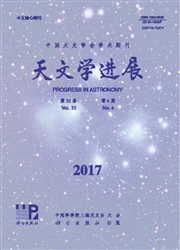

 中文摘要:
中文摘要:
综述了银河系光学和红外巡天的多种观测计划,主要介绍了巡天望远镜的基本参数、巡天的目的和任务、巡天的科学预期和产出,以及巡天计划的特点和意义等。其中,测光巡天方面主要包括SSS巡天,2MASS,UKIDSS,IPHAS,XSTPS和SDSS/SEGUE测光巡天等计划;光谱巡天方面主要包括RAVE,SEGUE光谱巡天,APOGEE,LEGUE和HERMES共5个计划。此外,还介绍了将对银河系研究领域产生深远影响的GAIA巡天和LSST巡天,以及WEAVE,4MOST和MOONS这3个作为对GAIA计划进行补充的地基巡天项目。
 英文摘要:
英文摘要:
Most of the Galactic baryons are in the form of stars which are mostly distributed in the Milky Way disk and halo. Therefore, large scale stellar survey plays an important role in the study of the Galactic structure and evolution. The most important survey bands are in the optical and near infrared (IR) in which the IR observation is extremely important for the disk and bulge regions since infrared radiation can penetrates through the interstellar dust. By analyzing the data of large scale photometric and/or spectroscopic survey in optical and infrared, one can get key parameters of stars, such as the brightness, colors, coordinates, radial velocities, chemical abundance and so on. These parameters are the basis of mapping the Milky Way structure and tracing the history of star formation and Galactic evolution as a whole. In this paper, we have summarized the main properties and scientific achievements of some famous Galactic photometric and spectroscopic survey projects. For the photometric survey, we have introduced the 2MASS and UKIDSS in infrared, and SSS, SDSS, IPHAS and XSTPS-GAC/LGL in optical. We have specifically emphasized in the XSTPS-GAC and -LGL projects which are the first large scale photometric surveys in China aiming at tracing the structure of the Milky Way disk. The XSTPS-GAC is carried out with the Xuyi 1.04/1.20 m Schmidt Telescope and SDSS g, r, i filters. From the year of 2009 to 2011, the survey has imaged a sky area of over 6000 sq.deg centered on the Galactic Anti-center, and generated a point source catalog containing about 1.0 × 108 stars on the Galactic Anti-center. The survey reaches a ten-sigma detection limit of about 19 mag, with a photometric accuracy about 1%-2% for a single frame. After combining all frames, the final astrometric accuracy is expected to be about 0.06″. For the spectroscopic survey, we introduce the RAVE, SEGUE, APOGEE, LEGUE, and HER- MES survey projects. We concentrated on the LEGUE project, which is a survey of millions of stars in the Milky Way disk
 同期刊论文项目
同期刊论文项目
 同项目期刊论文
同项目期刊论文
 AutomatedIdentification of 2612 Late-K and M Dwarfs in the LAMOST Commissioning DataUsing Classifica
AutomatedIdentification of 2612 Late-K and M Dwarfs in the LAMOST Commissioning DataUsing Classifica Progress in Research of Damped Lyman Alpha Systems (DLAs)(II): Methods of Measuring the Metal Column
Progress in Research of Damped Lyman Alpha Systems (DLAs)(II): Methods of Measuring the Metal Column The atomic-to-molecular transition and its relation to the scaling properties of galaxy discs in the
The atomic-to-molecular transition and its relation to the scaling properties of galaxy discs in the 期刊信息
期刊信息
